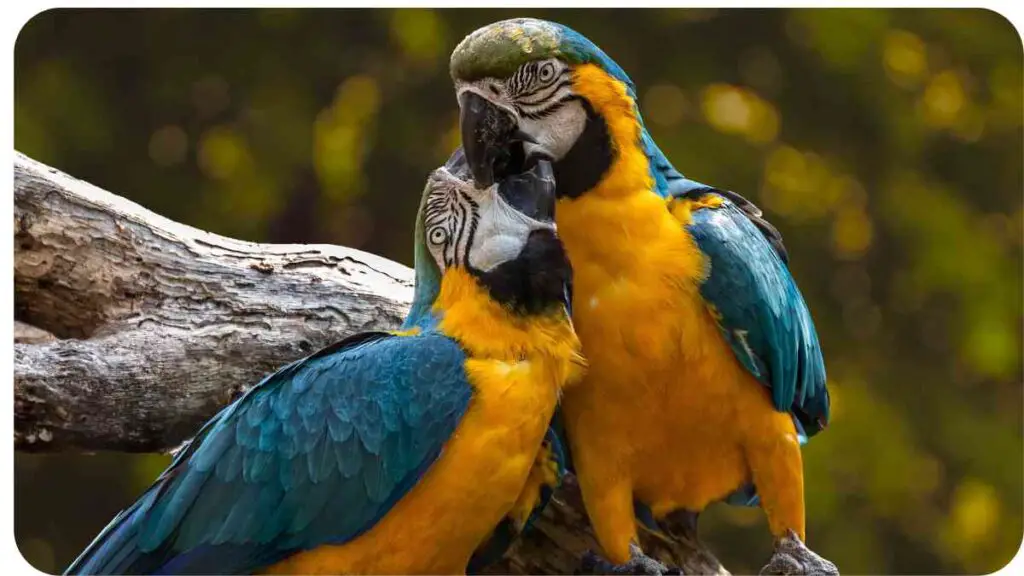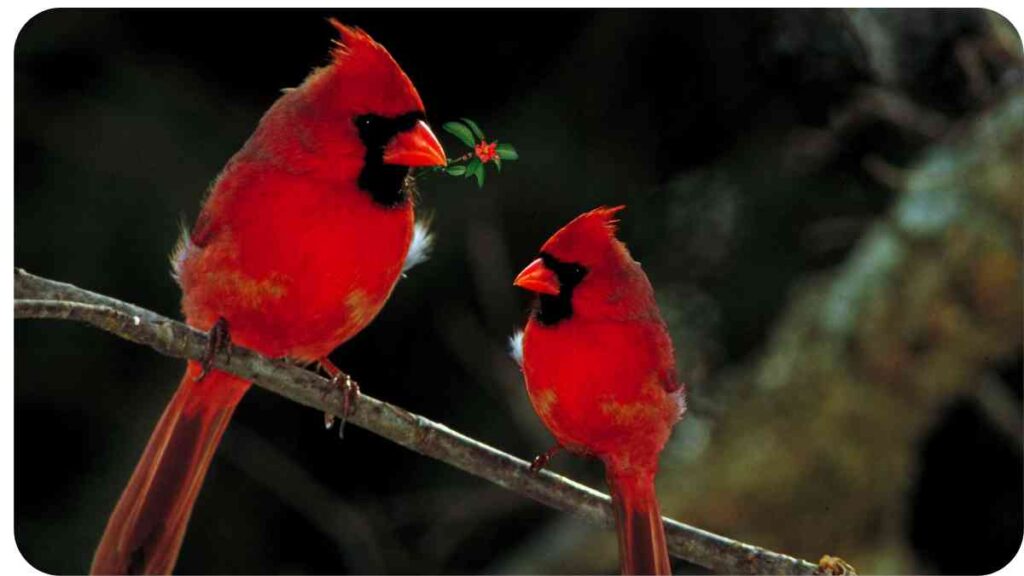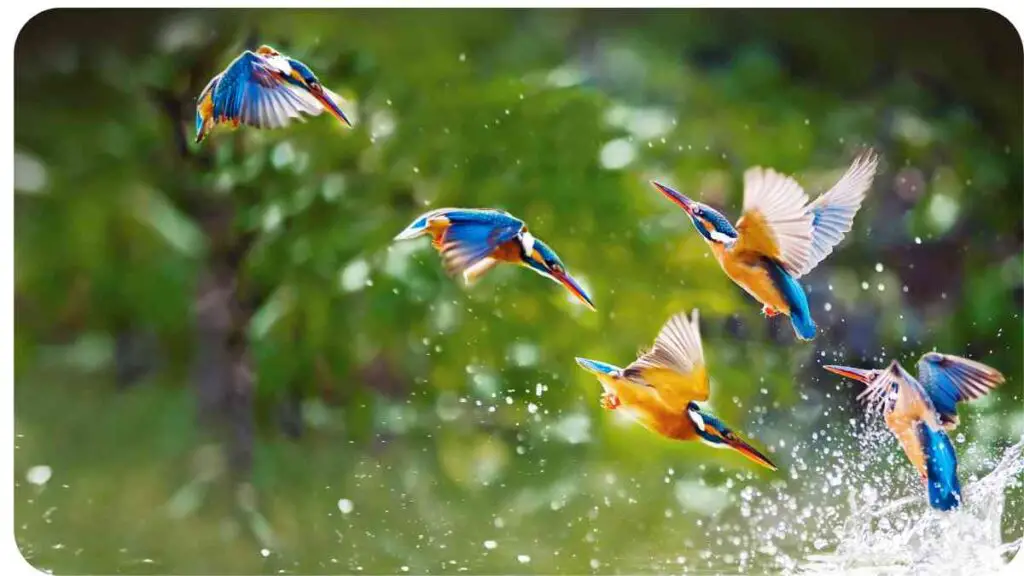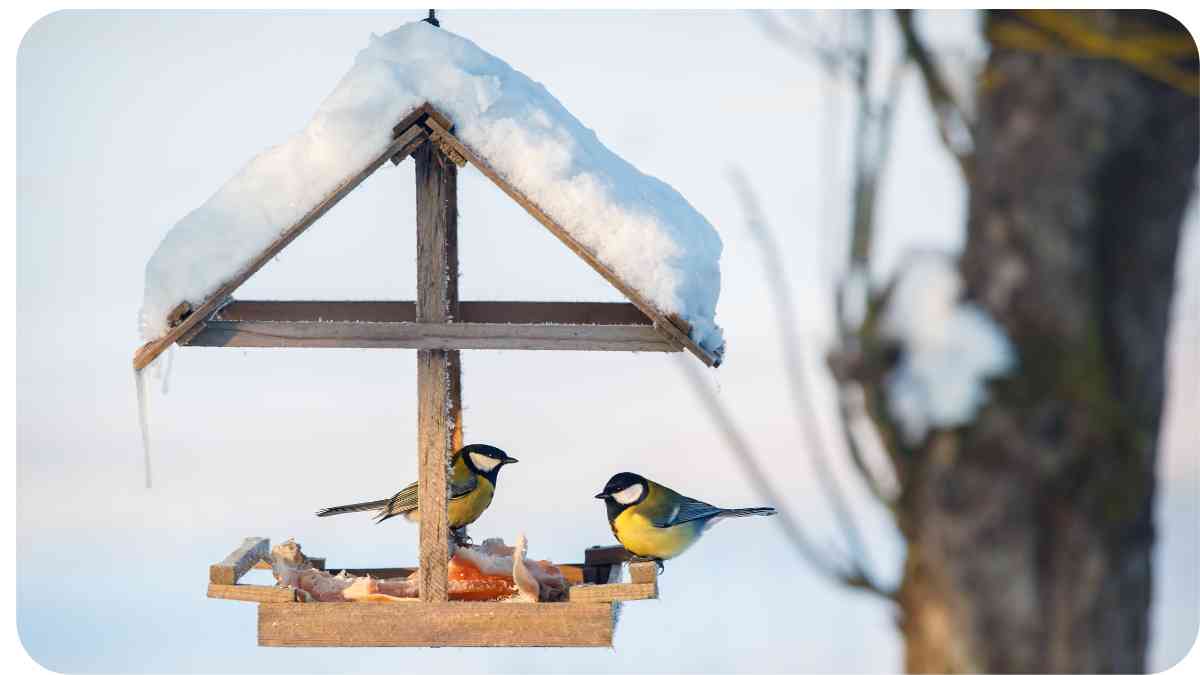Monogamous birds, with their lifelong affectionate bonds, offer a fascinating glimpse into the intricate world of avian relationships.
In this article, we’ll delve into the science behind monogamy, spotlight specific monogamous species, explore the benefits and challenges they face, and draw parallels to human relationships. Let’s soar into the captivating realm of monogamous birds.
| Takeaways |
|---|
| 1. Monogamy in birds is rooted in evolutionary and hormonal factors. |
| 2. Lifelong bonds contribute to shared parental responsibilities and increased offspring survival rates. |
| 3. Communication and rituals play a crucial role in maintaining healthy monogamous relationships. |
| 4. Human relationships can benefit from observing and applying lessons learned from monogamous bird behavior. |
| 5. Conservation efforts are vital to ensuring the continued existence of these remarkable avian bonds. |
The Science Behind Monogamy
Monogamy in birds isn’t just a random occurrence, it’s deeply rooted in evolutionary and hormonal factors. Understanding these elements sheds light on the reasons behind the enduring bonds observed in various avian species.
Understanding young bird bonds is crucial for appreciating the deep emotional connections formed by monogamous birds. Witnessing how play contributes to emotional development sheds light on the intricate nature of avian relationships.
Evolutionary Reasons for Monogamy

The concept of monogamy has evolved as a survival strategy for many bird species. By forming a lifelong bond, mates can work together to protect their territory, build nests, and raise offspring, increasing the chances of their genes being passed on to the next generation.
Hormonal Influences on Bond Formation
Hormones play a crucial role in the formation and maintenance of monogamous bonds. Oxytocin and vasopressin, often referred to as the “love hormones,” contribute to the emotional connection between mates. These hormonal influences extend beyond the nesting season, solidifying the pair’s commitment.
Explore the captivating world of wild bird affection, where intimate behaviors provide a unique window into the depths of emotional connections among free-living birds. This journey unveils the subtle nuances that make avian affection a fascinating subject of study.
Species Spotlight
Some species stand out as paragons of monogamy. Swans, with their graceful courtship dances, and albatross, known for their long-distance commitments, provide compelling examples of the diversity within monogamous relationships.
Swans: Iconic Monogamous Birds
Swans, with their elegant neck arches and synchronized movements, exemplify the beauty of monogamous bonds. These birds form strong connections through elaborate courtship rituals, often involving synchronized swimming and intricate displays of affection.
Delve into the fascinating realm of bird empathy, where deciphering expressions of empathy and compassion in bird behavior enhances our understanding of the profound emotional bonds that exist among avian species. Uncover the intricacies of their compassionate interactions.
Albatross: Long-Distance Monogamy Champions
Albatross, masters of long-distance flight, navigate vast oceans but always return to their lifelong mates. The endurance of their monogamous bonds, often lasting for years or even a lifetime, showcases the resilience and commitment found in avian relationships.
Table – Comparative Nesting Habits
| Species | Nesting Location | Nest Construction |
| Swans | Lakes and Ponds | Large Nests of Reeds |
| Albatross | Remote Islands | Simple Ground Nest |
Benefits of Monogamy in Birds

Monogamous birds enjoy various advantages, particularly in shared parental responsibilities and increased offspring survival rates. These benefits contribute to the evolutionary success of monogamous species.
Shared Parental Responsibilities
Monogamous pairs often share the responsibilities of incubating eggs, feeding chicks, and protecting the nest. This collaborative effort enhances the chances of reproductive success, as both mates actively contribute to the well-being of their offspring.
Increased Offspring Survival Rates
The commitment between monogamous mates leads to enhanced protection and care for their young. This increased parental investment significantly improves the survival rates of offspring compared to species with less stable family structures.
Explore the social significance of bird grooming and cuddling, illuminating the profound ways in which these behaviors contribute to the cohesive social fabric among avian communities. Discover the importance of grooming and cuddling in fostering strong bonds among birds.
Table – Lifespan and Reproductive Patterns
| Species | Lifespan | Reproductive Patterns |
| Swans | 20-30 years | Annual Nesting, 3-8 Eggs per Clutch |
| Albatross | Up to 50 years | Biennial Nesting, 1 Egg per Season |
Challenges in Monogamous Bird Relationships
While monogamous bonds offer benefits, birds also face challenges such as external threats and stressors. Understanding these challenges provides insights into the adaptability and coping strategies employed by avian couples.
External Threats and Stressors
Monogamous bird pairs encounter challenges from predators, environmental changes, and human activities. Navigating these threats requires effective communication and collaboration to ensure the survival of both mates and their offspring.
Coping Strategies in the Avian World
To overcome challenges, monogamous birds often exhibit remarkable resilience. Adaptive behaviors, such as altering nesting locations or adjusting feeding patterns, highlight the ability of these avian couples to navigate changing circumstances and protect their bond.
Gain insights into the unique bonds of affection shared between birds and humans. This exploration unravels the intricacies of the relationships formed between these two species, shedding light on the extraordinary connections that transcend traditional boundaries.
Table – Notable Monogamous Bird Conservation Projects
| Conservation Project | Target Species | Conservation Initiatives |
| Swan Conservation Program | Various Swan Species | Habitat Protection, Nesting Site Management |
| Albatross Preservation Fund | Albatross | Ocean Cleanup, Protection of Nesting Areas |
Table – Comparative Nesting Habits
| Species | Nesting Behavior | Incubation Period |
| Swans | Both Mates Contribute to Nest Building | Approximately 35 days |
| Albatross | Elaborate Courtship Rituals Before Nesting | Extended, up to 80 days |
Maintaining a Healthy Monogamous Bond
Communication and recognition are vital aspects of sustaining a thriving monogamous relationship in the avian world. Birds employ various strategies to strengthen their connection, from vocalizations to unique displays of affection.
Communication and Mate Recognition
Monogamous birds often communicate through distinctive calls and behaviors. These signals help mates locate each other, reinforce their bond, and coordinate activities such as nest building and hunting. The ability to recognize a mate’s unique features is crucial for successful pair formation and maintenance.
Rituals and Displays of Affection
Courtship rituals in monogamous birds go beyond the functional aspects of nesting and feeding. Expressions of affection, such as mutual preening and synchronized movements, reinforce the emotional connection between mates. These rituals serve as a foundation for a lasting and resilient bond.
Human Parallels: What We Can Learn
While the world of birds may seem distant from human experiences, there are valuable lessons to be learned from monogamous avian relationships. Applying these insights can enhance our understanding of commitment, communication, and the significance of shared responsibilities in human partnerships.
Relationship Lessons from Monogamous Birds
Monogamous birds demonstrate the importance of mutual support, communication, and the shared effort needed to overcome challenges. Whether it’s building a nest or raising offspring, the collaborative nature of these avian bonds offers inspiration for human relationships.
Applying Avian Wisdom in Human Relationships
Incorporating avian wisdom involves recognizing the unique qualities of a partner, effective communication, and a commitment to shared goals. By observing the behaviors of monogamous birds, we can gain insights into building enduring and fulfilling human relationships.
Research Findings and Studies
The scientific community has conducted extensive research on monogamous bird behavior, providing valuable insights into their ecology and behavior. These findings contribute not only to our understanding of avian life but also offer practical applications for conservation efforts.
Notable Research on Monogamous Bird Behavior
Research studies, such as those tracking migratory patterns and genetic diversity in monogamous species, deepen our understanding of avian behavior. These findings inform conservation strategies and contribute to the broader field of ornithology.
Insights for Conservation Efforts
Conserving monogamous bird species involves understanding their unique needs and challenges. By implementing habitat protection measures and addressing specific threats, we can contribute to the preservation of these remarkable avian relationships.
My Journey in Studying Monogamous Birds
Embarking on a journey to study monogamous birds has been a rich and rewarding experience. From the challenges of fieldwork to the awe-inspiring moments of witnessing intricate courtship displays, my personal encounters have fueled a deep appreciation for the complexity of avian relationships.
Personal Experiences in the Field
In the field, observing swans gracefully gliding across a tranquil pond or albatross engaging in elaborate courtship rituals is an experience like no other. These moments offer a glimpse into the intimate lives of monogamous birds, fostering a connection between observer and subject.
Challenges and Rewards of Avian Research
Studying monogamous birds comes with its set of challenges, from navigating diverse ecosystems to patiently waiting for rare behaviors. Yet, the rewards are immeasurable a deeper understanding of avian relationships and the satisfaction of contributing to their conservation.
Table – Notable Monogamous Bird Conservation Projects
| Conservation Project | Target Species | Conservation Initiatives |
| Swan Conservation Program | Various Swan Species | Habitat Protection, Nesting Site Management |
| Albatross Preservation Fund | Albatross | Ocean Cleanup, Protection of Nesting Areas |
| Lovebirds Sanctuary Initiative | Lovebirds | Reforestation, Anti-Poaching Measures |
Tips for Birdwatchers and Enthusiasts
For fellow birdwatchers and enthusiasts, maximizing the experience of observing monogamous bird behavior involves understanding their habitats, respecting their space, and actively contributing to conservation efforts.
Best Practices for Observing Monogamous Behavior
- Patience is Key: Observing intimate moments may require extended periods of observation.
- Respect Boundaries: Maintain a safe distance to avoid disturbing nesting sites and natural behaviors.
- Contribute to Conservation: Support local initiatives and contribute to habitat preservation.
Creating Bird-Friendly Environments

- Plant Native Species: Foster a bird-friendly environment by planting native trees and shrubs.
- Provide Nesting Spaces: Install birdhouses or nesting platforms to encourage breeding pairs.
- Limit Pesticide Use: Reduce the use of pesticides to protect the food sources of monogamous birds.
Table – Lifespan and Reproductive Patterns
| Species | Lifespan | Reproductive Patterns |
| Lovebirds | 10-15 years | Annual Nesting, 2-4 Eggs per Clutch |
Conclusion
In conclusion, the world of monogamous birds offers a tapestry of fascinating behaviors, challenges, and solutions. From the iconic swans to the resilient albatross, these avian relationships provide not only aesthetic pleasure but also valuable lessons for human connections.
As we marvel at the intricacies of monogamous bonds, let us remember our responsibility to contribute to the conservation of these remarkable species, ensuring that future generations can also witness the beauty of lifelong affectionate bonds in the avian world.
Further Reading
- Birds that Mate for Life – Safari Safricana: Explore a comprehensive guide on various bird species that form lifelong bonds. Gain insights into the behaviors, habitats, and conservation efforts related to these fascinating avian relationships.
- Birding Basics: Birds that Mate for Life – Birds and Blooms: Delve into the basics of birding and discover specific species known for their monogamous behaviors. This resource provides valuable information for both novice and experienced birdwatchers.
- Investing in Love and Affection Pays Off for Species that Mate for Life – UChicago News: Learn about the scientific perspective on the benefits of monogamy in the animal kingdom. This article explores the evolutionary advantages and ecological impact of species forming lifelong bonds.
FAQs
What is the significance of monogamy in bird species?
Monogamy in bird species is significant for various reasons, including increased reproductive success, shared parental responsibilities, and enhanced protection for offspring.
How do monogamous birds communicate with each other?
Monogamous birds communicate through a variety of means, including vocalizations, distinctive calls, and specific behaviors. These communication strategies strengthen the bond between mates and facilitate coordination in activities such as nesting and feeding.
Are all bird species monogamous?
No, not all bird species are monogamous. While many form lifelong bonds, others exhibit polygamous or promiscuous behaviors. The prevalence of monogamy varies across different bird families and species.
How can bird enthusiasts contribute to the conservation of monogamous bird species?
Bird enthusiasts can contribute to conservation efforts by supporting local initiatives, respecting nesting sites, and actively participating in habitat preservation. Additionally, spreading awareness about the importance of protecting these species is crucial.
Do monogamous birds ever separate from their mates?
While monogamous birds generally form long-lasting bonds, there are instances of separation, often due to external threats, environmental changes, or the death of a mate. However, many species exhibit fidelity and may seek new mates if separation occurs.

Hello! I’m Hellen James, and I’m a birdwatcher and birder. I have a personal interest in bird behavior and classifications and have been following the latest research on the topic for years.


